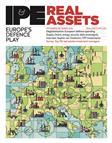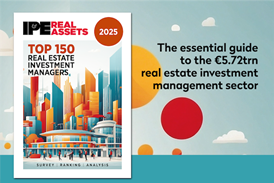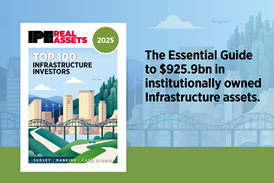Increases in operational risk and allocation pressures from infrastructure and private equity are putting property in a tight spot, write Andrea Orlandi and Valentina Shegoyan

Traditionally, real estate has occupied a significant role alongside equities and fixed income. It has been there to provide returns and diversification under the belief that it is uncorrelated to the other two. It was believed that real estate was less risky than pure equities and closer to fixed income due to the passive nature of its returns.
Two recent developments have challenged this assumption and have changed the role of real estate within portfolios. First, the digitalisation of the economy has made real estate a more fluid, short-term income-producing asset class. In simple terms, there is less reliance on permanent, fixed real estate for production. This has been evidenced by empty outdated buildings and shorter lease terms – for example, the average length of a commercial lease has shrunk to 4-5 years.
Real estate is no longer shielded from the underlying operating risk of the tenants. Arguably, it was never fully shielded, as tenants, operators and contractors always could renegotiate contracts – perhaps at a penalty – in the face of economic stress or commercial underperformance. The real estate performance was only as good as the underlying credit. Today, real estate owners have learned to manage the underlying operating risks. For example, in the exuberant data centre sector, rents are ultimately linked to energy usage and the IT sector.
Second, the performance of real estate in the past five years has been dispersed by sector but has generally been poor. A string of events has heavily hurt real estate returns, especially retail and offices:
- The rise of e-commerce and changing purchasing patterns have redefined the role of retail property;
- COVID-19 and the temporary closure of commercial physical assets triggered the subsequent restructuring of the office sector;
- The sudden readjustment of interest rates within a 12-month period in 2022-23 had an impact on financing costs, but more importantly, valuations;
- Geopolitical risk, such as the war in Ukraine, disrupted the raw material supply chain and sparked inflation, along with a shift away from China, a large once-desirable investment market.
The above events led to significant losses in the real estate portfolios of sovereign, pension and endowment funds, which had a knock-on effect for capital raising efforts of private equity funds. These losses seem to have been absorbed by the equity markets rather than the banking system, which took the burden in the global financial crisis.
These trends and consequent financial impacts have led to a reassessment of the understanding and role of real estate within any asset portfolio. Institutional investors empirically question the original promise of real estate. What are the structural consequences for real estate as an asset class? Immediately, we can identify two of them.
Real estate continues to be seen as an alternative asset class but now more aligned to infrastructure. In some organisations, this has led to either the two verticals being stapled to each other under the assumption of asset similarity and corporate cost efficiency, or real estate losing its allocations in favour of infrastructure as a better provider of stable returns. The former is especially driven by the overlap in data centres and the importance of warehousing. Note that modern warehouses are now becoming heavily IT-influenced structures.
Real estate and infrastructure share some structural features – physical assets, tenant credit risk – but they are fundamentally distinct. Infrastructure is traditionally based on long-term leases, often from assets in monopolistic or oligopolistic positions (thus the role of regulators) and where leverage is utilised as a significant enhancement of returns. Real estate is a heavily fragmented market with new supply potential where cash flows have been shown to be more short-term and volatile.
The second consequence has been the association with private equity. The argument that real estate is becoming another vertical within private equity is a reasonable one. Real estate investment, whether by asset (shorter-term leases) or structure (operating companies), has become more volatile and, therefore, riskier. The premise that real estate was shielded from operating risk has been removed.
It follows that if real estate is not a diversifier and private equity is a similar asset allocation alternative, the required return from real estate should be much higher. That creates a problem, because in the absence of interest rates decline it is difficult for real estate to produce those returns without devaluating existing positions and taking undue risk – thus, the recent dearth of investment transactions.
So will real estate survive as a distinct asset class? Absolutely, yes. Real estate continues to perform a productive role in portfolio diversification, and it does not fully share the structural qualities of infrastructure. While it does make sense to demand private equity returns from some riskier real estate assets, there are inherent qualities of real estate that render it more defensive – for example, supply constraints of new space and locational benefits.
However, real estate can no longer sit in a silo. The digital revolution has transformed the use and risk characteristics of the asset class, and the sector is much more competitive.
There are always short-term cyclical changes, but they usually happen within a wider secular trend. To claim that the recent severe downturn in real estate was purely cyclical would miss the underlying secular change within the asset class, which has greater consequences.
Some real estate private equity investors have been adept at working within the cyclical trends, and these structural changes may play to their strengths, but longer-term investors should be focused on the secular change of the real estate asset class.
Investors adopting a passive approach will struggle to perform as the market trends continue to accelerate with the role of the digital economy. Not acknowledging that real estate carries more volatility and operating risk would be a mistake leading to continued underperformance.
The professional characteristics needed to succeed in real estate have changed. Understanding good architecture, space design, maintenance and location are all still fundamental – perhaps even more so today – but managing real estate is now a more active exercise with greater risk and volatility.
Investment managers and investors should no longer view operating risk as a threat but as an opportunity. By demonstrating an ability to manage added complexity, they will be able to drive higher risk-adjusted returns. The era of real estate as a passive asset class is over. Today’s real estate crisis will give rise to a new wave of real estate managers who embrace asset-level underlying operating risk and who can manage operating platforms. These managers will see technology not just as a disruptor but as an asset to be leveraged to improve performance.
Leaders must understand these trends and adapt as investors demand higher returns. Only then will real estate continue to be a relevant and profitable asset class for institutional investors.


















